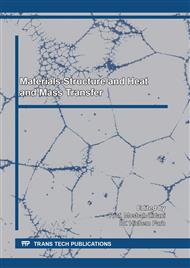[1]
R.P.R. Cardoso, O.B. Adetoro, A generalisation of the Hill's quadratic yield function for planar plastic anisotropy to consider loading direction, International Journal of Mechanical Sciences 128–129 (2017) 253–268.
DOI: 10.1016/j.ijmecsci.2017.04.024
Google Scholar
[2]
O. Chahaoui, M. L. Fares, D. Piot, F. Montheillet, Monoclinic effects and orthotropic estimation for the behaviour of rolled sheet, Journal of Materials Science 46: (2011)1655-1667.
DOI: 10.1007/s10853-010-4983-5
Google Scholar
[3]
N. Brinis, B. Regaiguia, O. Chahaoui, N. Maatougui, M. L Fares, Modelling Mechanical Properties of AISI 439-430Ti Ferritic Stainless-Steel Sheet, Journal of Solid Mechanics Vol. 11, No. 2, (2019). pp.425-439.
DOI: 10.4028/www.scientific.net/ssp.297.31
Google Scholar
[4]
R. Hill, A theory of yielding and plastic flow of anisotropic materials. Proceedings: Mathematical, Physical and Engineering Science, Royal Society London, A193 (1948) 281-297.
Google Scholar
[5]
Monica Iordache1, Mihaela Teaca1, 2, Isabelle Charpentier2, Marion Martiny2, Gérard Ferron2 Identification of sheet metal plastic anisotropy, and optimization of initial blank shape in deep drawing' the annals of "dunărea de jos, university of galaţi fascicle v, technologies in machine building, ISSN (2009) 1221- 4566.
Google Scholar
[6]
W.A Spitzig, R.J Sober, and O Richmond, Pressure dependence of yielding and associated volume expansion in tempered martensite, Acta Metallurgica, 23(7): (1975) 885 – 893.
DOI: 10.1016/0001-6160(75)90205-9
Google Scholar
[7]
W.A. Spitzig and O. Richmond, The effect of pressure on the flow stress of metals, Acta Metallurgica, 32(3):457 – 463, (1984).
DOI: 10.1016/0001-6160(84)90119-6
Google Scholar
[8]
T.B. Stoughton, A non-associated flow rule for sheet metal forming, International Journal of Plasticity, 18(5–6): (2002) 687–714.
DOI: 10.1016/s0749-6419(01)00053-5
Google Scholar
[9]
M. Safaei, M. G., Lee, S. L. Zang, and W. D. Waele, An evolutionary anisotropic model for sheet metals based on non-associated flow approach, Comput. Mater. Sci. (2014) 81, 15-29.
DOI: 10.1016/j.commatsci.2013.05.035
Google Scholar
[10]
H. Aretz, Numerical analysis of diffuse and localized necking in orthotropic sheet metals, International Journal of Plasticity 23 (2007) 798–840.
DOI: 10.1016/j.ijplas.2006.07.005
Google Scholar
[11]
O. Cazacu, F. Barlat, Generalization of Drucker's yield criterion to orthotropy, Mathematics and Mechanics of Solids 6 (2001) 613–630.
DOI: 10.1177/108128650100600603
Google Scholar
[12]
M. Kawka, A. Makinouchi, Plastic anisotropy in FEM analysis using degenerated solid element, Journal of Materials Processing Technology 60 (1996) 239–242.
DOI: 10.1016/0924-0136(96)02336-9
Google Scholar
[13]
O. Chahaoui, M.L. fares, D. Piot, F. Montheillet, Mechanical Modeling of the Macroscopic Behavior for Anisotropic and Heterogeneous Alloys, Metals and Materials International. Vol. 19, No. 5 (2013), p.1005~1019.
DOI: 10.1007/s12540-013-5013-3
Google Scholar
[14]
N. Brinis, B. Regaiguia, O. Chahaoui, N. Maatougui, M. L Fares, Modelling Mechanical Properties of AISI 439-430Ti Ferritic Stainless-Steel Sheet, Journal of Solid Mechanics Vol. 11, No. 2, (2019) pp.425-439.
DOI: 10.4028/www.scientific.net/ssp.297.31
Google Scholar
[15]
F Barlat, R.C Becker, T. Hayashida,Y. Maeda, M. Yanagawa, K. Chung, J.C Brem, D.J Lege, K Matsui., S.J. Murtha, S Hattori., Yielding description of solution strengthened aluminium alloys, International Journal of Plasticity 13: ,(1997) 185–401.
DOI: 10.1016/s0749-6419(97)80005-8
Google Scholar


